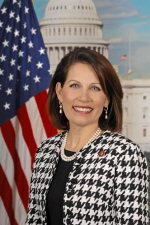Inside the SurveyUSA Poll of Minnesota’s 6th Congressional District
July 2010 poll shows notable sampling differences in percentage of males, independents, and voters above the age of 50 from spot-on late October 2008 poll of the district

The poll of what is shaping up to be one of the top two or three most expensive U.S. House races in the country was conducted of 565 6th CD likely voters and had a margin of error of 4.2 points.
Bachmann supporters will tout their candidate’s nine-point lead in the survey, 48 to 39 percent over Clark, while advocates for the DFL nominee will point out she is only down by single-digits in a GOP leaning district, in a GOP-trending year, and with a 2:1 deficit in funds raised to date compared to the Republican Congresswoman.
Bob Anderson and Aubrey Immelman, polling at 6 and 2 percent respectively three and a half months out from Election Day, will no doubt highlight the fact they are receiving an infinitely higher percentage of the vote for the amount of money they have raised compared to Bachmann and Clark.
While the media, political junkies, and activists in one camp or the other are scrutinizing the latest results, the new SurveyUSA poll does raise some interesting questions.
First of all, the SuveyUSA organization has a very accurate track record, including in Minnesota’s 6th Congressional District.
In SurveyUSA’s poll taken just a few days before the 2008 6th CD contest between Bachmann, DFLer Elwyn Tinklenberg and then independent candidate Anderson, the organization practically nailed the Election Day outcome.
That poll, conducted October 29-30, 2008 of 625 likely voters, had Bachmann at 46 percent, Tinklenberg at 45 percent, and Anderson at 6 percent, with 3 percent still undecided.
The election results a few days later: Bachmann at 46 percent, Tinklenberg at 43 percent, and Anderson at 10 percent.
Given the closeness with which the late October 2008 SurveyUSA poll tracked that November’s vote, there are some interesting differences between that sample and the new July 2010 survey.
It should be noted, of course, that some demographics are likely to change – for example, one might expect changes in partisan ID given the continuing shifting winds in the political environment.
The first notable difference that stands out between the two polls is in the gender breakdown.
In the 2008 poll, 51 percent of the sample were women and 49 percent were men. In the new poll, 54 percent are men while just 46 percent are women – a 10-point swing.
The American Community Survey (ACS) 2006-2008 data finds 50.7 percent of Minnesota’s 6th CD are males and 49.3 percent are females.
Of course, the ACS data tracks the population as a whole, not likely voters, which tend to be slightly more female than male statewide.
For example, in the 2008 general election, 53 percent of Gopher State voters were female, according to CNN’s exit polling data.

A second interesting difference between the two polls is the partisan breakdown of the samples.
In the October 2008 survey, 74 percent identified with one of the two major political parties: 41 percent Republican and 33 percent Democrat. In the July 2010 survey, just 64 percent identified with the major parties: 36 percent Republican and 28 percent Democrat.
The percentage of self-identified independents was just 23 percent in the October ’08 survey and 31 percent in July ’10.
The decline in identification with both major parties – and the accompanying rise in identification as a political independent – should come as no surprise for those tracking the dissatisfaction among Americans with both Congressional Democrats and Republicans in the extremely partisan 111th Congress.
The big difference in 2010, however, is that Bachmann is receiving the support of 46 percent of independents, compared to just 35 percent in the late October 2008 survey.(Note: the margin of error is higher than 4.2 points among population sub-groups).
The third notable difference between the two samples involves the age of those surveyed.
In the 2008 survey, 57 percent of the sample was under the age of 50, with 43 percent at 50 or above. In the new poll, 47 percent were below the age of 50 and 53 percent at or above the mid-century mark – or a swing of 20 points.
Perhaps there is less interest in the 2010 race among younger 6th CD residents given it is a midterm election year, without the elevated interest that the 2008 presidential race seemed to engender among younger Americans in some districts across the country.
The biggest drop in the two samples was among those aged 18-34: falling from 19 percent of the sample in October 2008 to just 13 percent in the new poll.
It should be noted there were several demographic variables which demonstrated identical or virtually identical sampling in the two surveys. For example:
· Guns: 57 percent of each poll’s voters were gun owners
· Religion: 51 percent were regular attendees of church services in both surveys
· Ideology: In the 2008 poll, 39 percent identified as conservatives, with 44 percent moderate, and 14 percent liberal. In the new survey, 40 percent identified as conservative, 43 percent as moderate, and 13 percent as liberal.
Given the high interest and financial investment in the 6th CD race – both nationally and within the Gopher State – there will no doubt be additional horserace polls to dissect before Election Day.
Follow Smart Politics on Twitter.

The age breakout swing between 2008 and latest poll — could that be due to higher cell phone use in younger group? Did they call land lines only? I think this was a problem in 2008 polling as well.
“First of all, the SuveyUSA organization has a very accurate track record, including in Minnesota’s 6th Congressional District.”
I would most certainly like to see what source you’re using for this determination. Nothing I’ve read about comparative polling companies shows this to be true.
The earliest publicly available poll in 2008 was conducted in late August, so polls are being conducted unusually early this year.
The table below reports data from all five publicly released polls in the 2008 election cycle. If the layout makes the table difficult to interpret, go to http://www.immelman.us/news/bachmann-steady-post-hardball/ for the original table.
———————————— Bachmann — Tinklenberg — Anderson — Undecided
Grove Insight (Aug. 19-21) —— 40 —— 27 —— No data —— No data
Grove Insight (Oct. 10-12) —— 42 —— 38 —— No data —— 15
Public Opinion Strategies (Oct. 12-13) —— 44 —— 33 —— 8 —— No data
SurveyUSA (Oct. 20-21) —— 44 —— 47 —— 6 —— 2
MPR/UofM (Oct. 21-23) —— 43 —— 45 —— 5 —— 7
Mean —— 42.6 —— 38 —— 6.3 —— 8.8
Standard deviation —— 1.5 —— 7.4 —— 1.2 —— 5.4
In summary, inspection of the two pre- and two post-Hardball (Oct. 17) polls offers no evidence that Rep. Bachmann lost any voter support as a result of the “anti-America” remarks she made on Hardball and the political firestorm that followed.
What changed is that Tinklenberg’s poll numbers advanced by double digits in a matter of days, most likely reflecting a combination of improved name recognition and movement in his direction by independent and undecided voters.
Finally, Bachmann’s 48% in the current SurveyUSA poll is 4 percentage points higher than she received in any poll conducted in 2008, which indicates that she is running stronger than two years ago. Clark’s 39% is marginally better than Tinklenberg’s 33-38% prior to the Hardball incident (but less than his 45-47 post-Hardball polling). Anderson’s 6% is in the same range as the 5-8% he polled in 2008.
In conclusion, if the election were held today, the outcome would be the same as in 2008, with a slightly higher margin of victory for Bachmann.
> “First of all, the SuveyUSA organization has a very accurate
> track record, including in Minnesota’s 6th Congressional
> District.”
>
> I would most certainly like to see what source you’re using for
> this determination. Nothing I’ve read about comparative
> polling companies shows this to be true.
For example, SurveyUSA is ranked 3rd out of dozens of pollsters at 538.com for its “Pollster Introduced Error” rating system.
http://www.fivethirtyeight.com/search/label/pollster%20ratings
Analysis
The table below reports data from the two available surveys of the U.S. House race conducted thus far during the 2010 election cycle in Minnesota’s 6th Congressional District. (If the layout makes the table difficult to interpret, go to http://www.immelman.us/news/mn-06-bachmann-clark-polling/ for the original table.)
Public Policy Polling (Dec. 17-20)
Bachmann 55
Clark 37
[Anderson – not surveyed]
[Immelman – not surveyed]
Undecided 8
KSTP/SurveyUSA (Jul. 9-11)
Bachmann 48 [-7 since Dec. 2009 poll]
Clark 39 [+2 since Dec. 2009 poll]
Anderson 6
Immelman 2
Undecided 5 [-3 since Dec. 2009 poll]
Comparison of the December 2009 and July 2010 poll results shows that Independence Party nominee Bob Anderson and unaffiliated independent candidate Aubrey Immelman (Bachmann’s 2008 Republican challenger) are jointly shaving about 8 percentage points off Bachmann’s poll numbers.
Specifically, Bachmann shed 7 percentage points from the first poll to the second. That can be accounted for by the combined 8 points in the second poll for Anderson and Immelman, two conservative candidates whose names did not appear on the first survey.
In addition, Clark’s 2-point gain since the first poll comports with the 3-point reduction in the Undecided column. It is plausible that Clark’s active campaigning and improved name recognition since the first poll accounts for the reduction in undecided voters.